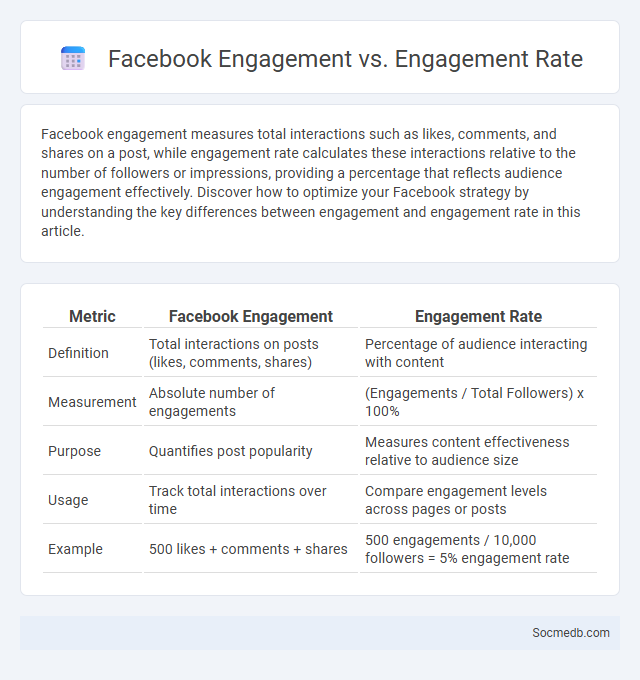
Photo illustration: Facebook Engagement vs Engagement Rate
Facebook engagement measures total interactions such as likes, comments, and shares on a post, while engagement rate calculates these interactions relative to the number of followers or impressions, providing a percentage that reflects audience engagement effectively. Discover how to optimize your Facebook strategy by understanding the key differences between engagement and engagement rate in this article.
Table of Comparison
| Metric | Facebook Engagement | Engagement Rate |
|---|---|---|
| Definition | Total interactions on posts (likes, comments, shares) | Percentage of audience interacting with content |
| Measurement | Absolute number of engagements | (Engagements / Total Followers) x 100% |
| Purpose | Quantifies post popularity | Measures content effectiveness relative to audience size |
| Usage | Track total interactions over time | Compare engagement levels across pages or posts |
| Example | 500 likes + comments + shares | 500 engagements / 10,000 followers = 5% engagement rate |
Understanding Facebook Engagement
Facebook engagement measures the interaction between your content and users through likes, comments, shares, and reactions, reflecting audience interest and content relevance. High engagement rates indicate strong community connection, increased organic reach, and improved algorithm ranking on Facebook. Optimizing post timing, using compelling visuals, and encouraging meaningful conversations boosts your Facebook engagement effectively.
What is Engagement Rate on Facebook?
Engagement rate on Facebook measures the level of interaction users have with content, calculated by dividing total engagements (likes, comments, shares) by the total reach or impressions. A higher engagement rate indicates that the audience finds the content relevant and compelling, boosting organic reach and visibility. Brands use this metric to evaluate campaign effectiveness and optimize future social media strategies.
Defining General Engagement in Social Media
General engagement in social media refers to the interaction metrics that indicate how actively users participate with content, including likes, comments, shares, and clicks. Your ability to measure engagement helps gauge audience interest, content relevance, and overall brand influence across platforms like Facebook, Instagram, and Twitter. Tracking these interactions provides valuable insights for optimizing social media strategy and improving communication effectiveness.
Key Differences: Engagement vs Engagement Rate
Social media engagement measures the total interactions such as likes, comments, shares, and clicks a post receives, reflecting overall audience activity. Engagement rate calculates these interactions as a percentage of total followers or impressions, providing a normalized metric to compare performance across different audience sizes. Brands use engagement to gauge content popularity, while engagement rate offers deeper insights into content effectiveness and audience connection.
Measuring Facebook Engagement: Metrics That Matter
Measuring Facebook engagement involves tracking key metrics such as likes, comments, shares, and click-through rates to understand how your audience interacts with your content. Monitoring post reach and engagement rate provides insight into the effectiveness of your campaigns and helps identify content that resonates most with your followers. By analyzing these metrics, you can refine your social media strategy to boost Your brand visibility and foster stronger connections.
The Formula Behind Facebook Engagement Rate
Facebook engagement rate is calculated by dividing the total number of interactions (likes, comments, shares) by the total number of followers or reach, then multiplying by 100 to get a percentage. Your engagement rate reflects how effectively your content resonates with your audience, providing insights into post quality and community involvement. Tracking this metric helps optimize content strategy, boosting visibility and fostering stronger connections on the platform.
Why Engagement Rate Matters for Marketers
Engagement rate measures the level of interaction between a brand's content and its audience, making it a critical metric for marketers to evaluate campaign effectiveness and audience interest. High engagement rates indicate that content resonates with followers, leading to increased brand loyalty and higher conversion potential. Tracking engagement also helps marketers refine strategies by identifying which types of posts generate meaningful responses and drive customer action.
How to Improve Your Facebook Engagement
Boosting Facebook engagement requires consistent posting of high-quality, relevant content tailored to your target audience's interests and behaviors. Utilizing interactive elements such as polls, live videos, and questions can significantly increase user interaction and dwell time on your page. Analyzing Facebook Insights helps identify peak activity times and top-performing posts, enabling data-driven adjustments to your content strategy for maximizing reach and engagement.
Interpreting Your Facebook Engagement Metrics
Understanding Facebook engagement metrics involves analyzing likes, comments, shares, and post reach to gauge audience interaction and content effectiveness. High engagement rates signal strong content resonance and community interest, helping businesses optimize future posts for better visibility. Tracking these metrics regularly enables marketers to refine strategies, improve customer connection, and increase overall social media ROI.
Facebook Engagement: Best Practices and Tips
Maximize your Facebook engagement by consistently posting high-quality, relevant content tailored to your target audience's interests and behaviors. Use compelling visuals, interactive elements like polls or questions, and respond promptly to comments to foster active community interaction. Analyze Facebook Insights regularly to refine posting times and content strategies, ensuring your posts reach and resonate with your followers effectively.
 socmedb.com
socmedb.com